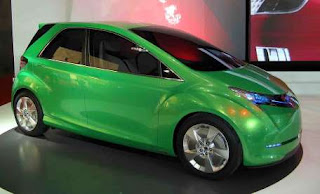 Just when you figure you’ve seen everything, something comes around that sets you back on your heels. Such is life in the world of advanced technology vehicles.
Just when you figure you’ve seen everything, something comes around that sets you back on your heels. Such is life in the world of advanced technology vehicles.This is especially so when it comes to electric cars. By most accounts in recent years, the battery electric vehicle had died an untimely death. Green Car Journal editors didn’t believe it then and we don’t now. But realistically, in the eyes of most folks there wasn’t much going on to dispute this. That view is turned on its ear by the Venturi Fétish, an unlikely and curvaceous example that epitomizes what the ultimate electric supercar should be.

The Venturi Fétish made its U.S. debut earlier this year in Los Angeles and then followed suit in Monaco, showings that followed an appearance in Paris. Here, it was eye-opening even by car-crazed California standards, with a sleek body drawn by French designer Sacha Lakic and engineering handled by Gérard Ducarouge of Lotus Formula 1 fame. It is assembled in California, where this elegant carbon fiber bodyshell is wrapped around a carbon aluminum honeycomb monocoque chassis, creating a 2,424 pound sports car that’s as aesthetically pleasing as any of the high-end exotics plying the roads of Hollywood or Beverly Hills.
 But this car isn’t all looks. A 300 horsepower, 14,000 rpm AC Propulsion electric motor propels the rear-drive Fétish from 0 to 60 mph in less than 5 seconds, achieving a top speed above 100 mpg. A T-shaped battery pack incorporating 770 pounds of lithium-ion batteries provides the power, a configuration similar to that of the nickel-metal-hydride battery design in GM’s EV1 electric car. This 58 kilowatt-hour Li-Ion pack reportedly allows the car a single-charge driving range of 200 miles. Regenerative braking recaptures energy during deceleration or braking and feeds electricity back to the batteries. Unlike most electric cars, the amount of regeneration is driver-adjustable at the dash. The car rides on Michelin Pilot Sport tires wrapped around aggressive 18 inch alloy wheels up front, with Michelins over 19-inch alloys at the rear.
But this car isn’t all looks. A 300 horsepower, 14,000 rpm AC Propulsion electric motor propels the rear-drive Fétish from 0 to 60 mph in less than 5 seconds, achieving a top speed above 100 mpg. A T-shaped battery pack incorporating 770 pounds of lithium-ion batteries provides the power, a configuration similar to that of the nickel-metal-hydride battery design in GM’s EV1 electric car. This 58 kilowatt-hour Li-Ion pack reportedly allows the car a single-charge driving range of 200 miles. Regenerative braking recaptures energy during deceleration or braking and feeds electricity back to the batteries. Unlike most electric cars, the amount of regeneration is driver-adjustable at the dash. The car rides on Michelin Pilot Sport tires wrapped around aggressive 18 inch alloy wheels up front, with Michelins over 19-inch alloys at the rear.Inside, Venturi offers its buyers a choice of leather or neoprene upholstery, form-fitting racing style seats, a thickly-wrapped steering wheel, and digital instrumentation. A wide array of advanced electronics is at a driver’s fingertips including an Apple Mini i-Pod MP3 player and an Alpine touch-screen multimedia station, which includes GPS navigation and DVD.
















































